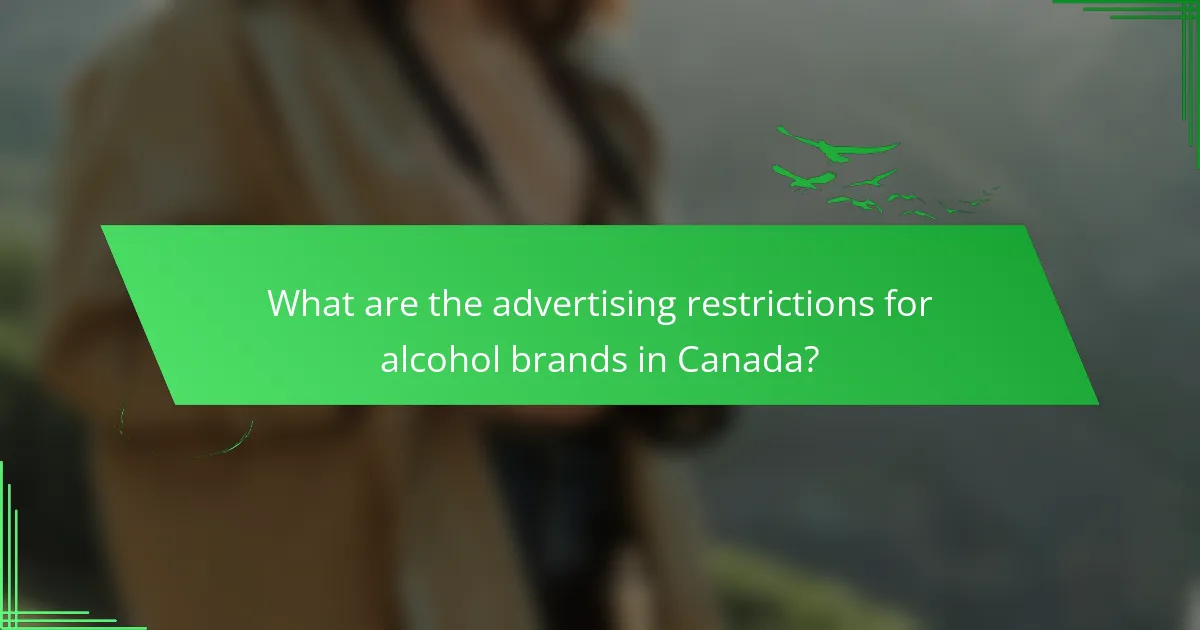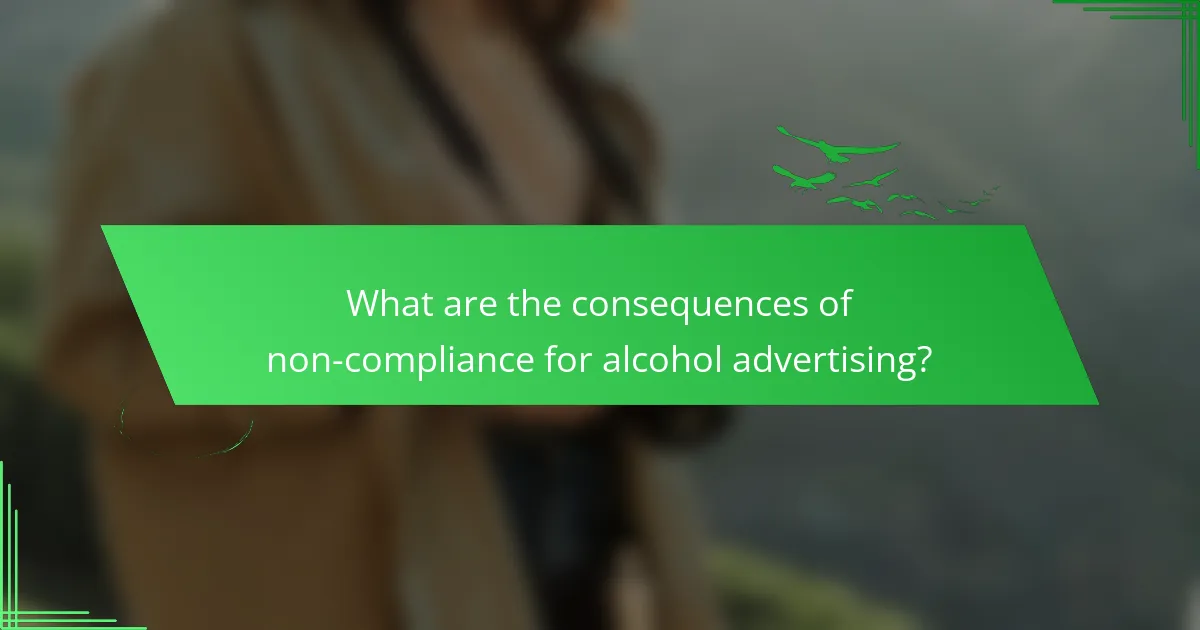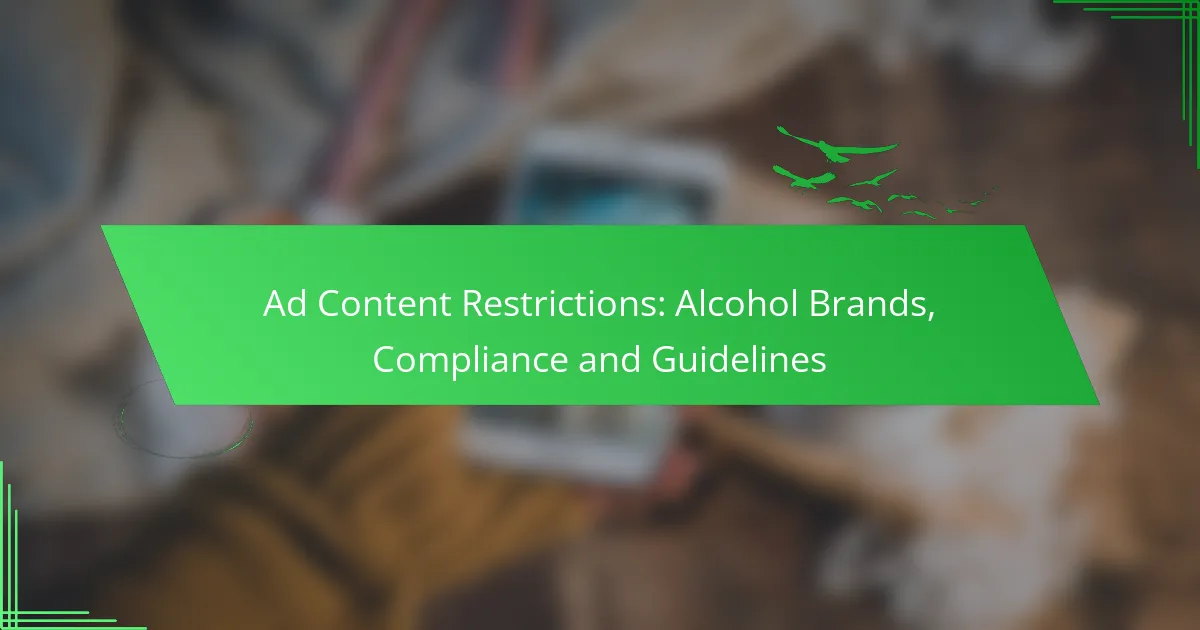Advertising for alcohol brands is subject to a complex array of regulations that vary by province and country, aimed at promoting responsible consumption and preventing misleading practices. To ensure compliance, brands must navigate these legal frameworks carefully, often consulting with legal experts and following internal guidelines. Failure to adhere to these regulations can result in severe penalties, reputational damage, and legal challenges that may affect a brand’s market presence.

What are the advertising restrictions for alcohol brands in Canada?
In Canada, advertising restrictions for alcohol brands are governed by a mix of provincial regulations, federal guidelines, and industry standards. These rules aim to promote responsible drinking and prevent misleading advertising practices.
Provincial regulations
Each province in Canada has its own set of regulations regarding alcohol advertising. For instance, British Columbia prohibits ads that appeal to minors or promote excessive consumption. In contrast, Ontario requires that all advertisements include a responsible drinking message. Brands must familiarize themselves with the specific regulations in each province where they operate.
Additionally, some provinces have restrictions on the placement of alcohol ads, such as prohibiting them near schools or playgrounds. Understanding these local laws is crucial for compliance and effective marketing.
Federal guidelines
At the federal level, the Canadian Radio-television and Telecommunications Commission (CRTC) oversees broadcasting regulations that apply to alcohol advertising. These guidelines emphasize that ads must not promote irresponsible drinking or suggest that alcohol enhances social or sexual success.
Moreover, the federal government mandates that all alcohol advertisements must include health warnings about the risks of drinking. This ensures that consumers are informed about the potential dangers associated with alcohol consumption.
Industry standards
In addition to government regulations, the alcohol industry has established its own standards through organizations like the Association of Canadian Distillers and the Canadian Beverage Alcohol Association. These standards often include guidelines on responsible messaging and the portrayal of alcohol in advertising.
Brands are encouraged to adopt self-regulatory practices, such as ensuring that their advertisements do not target minors and promoting moderation. Adhering to these industry standards can enhance a brand’s reputation and foster consumer trust.

How do alcohol brands ensure compliance with advertising laws?
Alcohol brands ensure compliance with advertising laws by adhering to established legal frameworks, consulting legal experts, and implementing internal guidelines. These steps help brands navigate the complex landscape of regulations that vary by country and region.
Reviewing legal frameworks
Alcohol brands must familiarize themselves with the legal frameworks governing advertising in their target markets. This includes understanding local laws, industry codes, and self-regulatory guidelines that dictate what can and cannot be advertised.
For instance, in the United States, the Federal Trade Commission (FTC) and the Alcohol and Tobacco Tax and Trade Bureau (TTB) set specific rules for alcohol advertising. Brands should regularly review these regulations to stay compliant and avoid penalties.
Consulting legal experts
Engaging legal experts who specialize in alcohol advertising laws is crucial for brands. These professionals can provide insights into the nuances of compliance and help interpret complex regulations.
Brands may consider retaining outside counsel or compliance consultants to conduct audits of their advertising practices. This proactive approach can identify potential legal issues before they arise, minimizing risks associated with non-compliance.
Implementing internal guidelines
Establishing robust internal guidelines is essential for ensuring consistent compliance across all advertising efforts. These guidelines should outline the standards for messaging, imagery, and target audience considerations.
For example, brands can create a checklist that includes reviewing all advertising materials for adherence to legal standards before publication. Regular training sessions for marketing teams on compliance issues can also reinforce these guidelines and promote a culture of accountability.

What are the consequences of non-compliance for alcohol advertising?
Non-compliance with alcohol advertising regulations can lead to serious repercussions, including financial penalties, damage to brand reputation, and potential legal actions. These consequences can significantly impact an alcohol brand’s operations and market presence.
Fines and penalties
Alcohol brands that fail to adhere to advertising regulations may face substantial fines. These penalties can range from thousands to millions of dollars, depending on the severity of the violation and the jurisdiction. For example, in the United States, fines can vary widely based on state laws and the nature of the infraction.
In addition to direct fines, brands may incur additional costs related to compliance audits and legal fees. It is crucial for companies to stay informed about local regulations to avoid unexpected financial burdens.
Reputational damage
Non-compliance can lead to significant reputational harm for alcohol brands. Negative publicity from violations can erode consumer trust and loyalty, which are vital for long-term success. Brands may find themselves facing public backlash, particularly if the violation is widely reported.
To mitigate reputational risks, companies should proactively communicate their commitment to responsible advertising practices. Engaging with consumers and stakeholders can help rebuild trust if a violation occurs.
Legal actions
Failure to comply with advertising regulations can result in legal actions from regulatory bodies or competitors. These actions may include lawsuits or cease-and-desist orders, which can disrupt business operations and lead to costly settlements. In some cases, brands may also face class-action lawsuits from consumers.
To minimize the risk of legal troubles, alcohol brands should implement robust compliance programs that include regular training for marketing teams and thorough reviews of advertising materials. This proactive approach can help identify potential issues before they escalate into legal challenges.

What are best practices for alcohol advertising in Canada?
Best practices for alcohol advertising in Canada focus on responsible messaging, targeting appropriate audiences, and promoting moderation. Advertisers must adhere to guidelines that ensure their content is ethical and compliant with local regulations.
Targeting responsible audiences
Alcohol advertising should specifically target adults of legal drinking age, which varies by province but typically ranges from 18 to 19 years old. Advertisers must avoid content that appeals to minors or suggests that drinking is a necessary part of socializing.
Utilizing demographic data can help brands reach responsible audiences effectively. This includes analyzing age, interests, and lifestyle factors to ensure that ads are placed in suitable contexts, such as adult-oriented events or platforms.
Promoting moderation
Effective alcohol advertising should always promote moderation and responsible consumption. This can be achieved by including messages that encourage drinking in moderation, such as “Please drink responsibly” or “Enjoy in moderation.”
Brands can also showcase low-alcohol or non-alcoholic options to appeal to consumers looking for alternatives. Highlighting food pairings or social activities that do not revolve solely around drinking can further reinforce a message of moderation.
Clear messaging
Clear and straightforward messaging is crucial in alcohol advertising. Advertisements should avoid ambiguous language and ensure that the intended message is easily understood. This includes clearly stating the product type and its alcohol content.
Additionally, compliance with local regulations regarding health warnings and age restrictions is essential. Including disclaimers about the risks of excessive drinking can enhance transparency and build trust with consumers.

What role do social media platforms play in alcohol advertising compliance?
Social media platforms play a crucial role in ensuring that alcohol advertising complies with legal and ethical standards. They establish specific guidelines and policies that brands must follow to promote their products responsibly and within the bounds of local regulations.
Platform-specific guidelines
Each social media platform has its own set of guidelines regarding alcohol advertising, which can vary significantly. For instance, Facebook and Instagram require that ads target users who are of legal drinking age in their respective countries, while also prohibiting content that promotes excessive consumption.
Brands should familiarize themselves with these platform-specific rules to avoid ad rejections or account suspensions. For example, TikTok may have stricter content restrictions compared to Twitter, emphasizing the need for tailored strategies across different platforms.
Content moderation policies
Content moderation policies on social media platforms are designed to enforce compliance with advertising standards. These policies often include automated systems and human reviewers who assess whether ads meet the established guidelines.
Brands should be prepared for potential delays in ad approvals due to these moderation processes. It is advisable to submit ads well in advance of any planned campaigns and to ensure that all content is compliant with both platform rules and local regulations to minimize issues.
